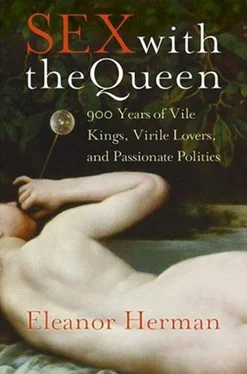The French court, however, saw this as the perfect opportunity to outshine their Spanish rivals and ordered opulent carriages and lavish clothing. The queen mother emptied the national treasury and then went headlong into debt to impress the Spanish with the magnificence of France. When her ministers reproached her, she replied that “the reason wherefore she sanctioned so great an outlay of money, for the reputation of the kingdom must be maintained, at least in outward matters, the more especially as the national funds were failing.” 35
Hearing of this, Philip sadly agreed that his court must not be outdazzled by the French, and he allowed the Spanish entourage the same expenditures. When Philip heard of the large number of courtiers accompanying King Charles, he reluctantly tripled the number in Elizabeth’s retinue. In addition to new wardrobes and carriages, both sides would bring with them their own furniture, drapes, tapestries, tables, beds, bedsheets, and silverware, on pack mules and in carts, crossing plains and mountains in biting rain and broiling sun. These items, too, must impress with their magnificence.
On April 9 Elizabeth set out for Bayonne. But the Spanish queen could not take a speedy, direct route. Cities and towns along the way clamored for her visit. Townspeople organized parades; artisans crafted triumphal arches for her carriage to pass through. Mayors and city councilmen gave lengthy speeches praising their queen and arranged long banquets in her honor. Churches insisted that she pray at their altars, worship their saints, and march in their processions. Poorhouses and orphanages begged her to stop by with alms. By the time the exhausted Elizabeth reached Bayonne, the journey had taken her almost nine weeks and her mother had been stewing for a fortnight in a heat wave.
Notified of the imminent arrival of the Spaniards, on June 14 King Charles and Queen Catherine waited in the royal pavilion for two hours. Six soldiers assigned to stand guard outside died of sunstroke. It is likely that Elizabeth’s vicious majordomo, the duque de Alba, who hated Catherine, indulged in a little revenge by making the queen of France sweat beneath her gold embroidered velvets. When the Spanish entourage approached, thirty-five of the noblest ladies rode sidesaddle on mules, to the hearty guffaws of French courtiers who thought the sight ridiculous. During the heartwarming reunion of mother and daughter, hundreds of courtiers were roaming the nearby villages seeking food and shelter. Catherine was forced to step in to prevent famine and pestilence; she unceremoniously ejected the villagers from their houses, which she assigned to courtiers.
In between the jousts, pageants, feasts, masked balls, artificial combats, fetes, and galas, the several political conversations between mother and daughter proved fruitless; Catherine exerted pressure on Elizabeth to influence Philip on issues that would benefit France, and not necessarily Spain. The duque de Alba, furious at Catherine’s misguided political efforts, informed her that her daughter must return forthwith to Spain, as her husband could no longer live with her absence.
Catherine’s parting instructions to Elizabeth were oddly impossible—that she was to “follow the humor of the king her husband in all matters, and above all, never to forget or to slight the interests of her brother’s crown.” 36
The expense, the wrangling, and the wasted months and futile political negotiations of this visit served as an example to future generations of royals. Family reunions would be few and far between, if ever. In 1699 Elizabeth Charlotte, duchesse d’Orléans, hoped to visit her pregnant daughter who had married the ruler of the duchy of Lorraine. Because no one in either party was a king—her husband, Monsieur, was a duke, as was her daughter’s husband—she hoped the visit would not be prevented by the fractious demands of protocol.
But the duc de Lorraine insisted on sitting in an armchair in the presence of the duc d’Orléans, an honor he was accorded by the Holy Roman Emperor. The duc d’Orléans, however, citing French etiquette, replied that the duc de Lorraine would only be given a stool to sit upon. When the duc de Lorraine flat-out refused to sit on a stool, the duc d’Orléans generously suggested that he be given a high-backed chair with no arms. But the duc de Lorraine stubbornly insisted on having a chair with arms. Louis XIV himself became involved and forbade the duc de Lorraine to sit on a chair with arms, signaling a dignity equal to that of Monsieur, whose dignity as a son of France was incomparably greater. However, the duc de Lorraine refused to admit he was worthy of less dignity than that given him by the emperor. And so the visit was called off, and Elizabeth Charlotte did not see her daughter for nearly two decades.
While commoners envied the luxuries of royal women, the fact was that many princesses had less spending money than a farmer’s wife. In 1666 King Alfonso VI of Portugal denied his French-born queen money for her household expenses and refused to give her the fifty thousand francs she had been promised as her wedding portion. Unable to pay her servants or buy herself a new gown, Queen Maria Francisca was often seen sobbing loudly into a handkerchief.
In the 1840s the thrifty King Ludwig I of Bavaria made his wife, Queen Therese, wear threadbare dresses to the opera, the same opera where his greedy mistress, Lola Montez, arrived shining in a diamond tiara, necklace, brooch, earrings, bracelets, and rings—gifts from the king.
Despite her exalted position as the highest-ranking woman in France after the death of Louis XIV’s queen in 1683, Elizabeth Charlotte suffered for decades from her husband’s stinginess. “All he has in his head are his young fellows,” she wrote, “with whom he wants to gorge and guzzle all night long, and he gives them huge sums of money; nothing is too much or too costly for these boys. Meanwhile, his children and I barely have what we need. Whenever I need shirts or sheets it means no end of begging, yet at the same time he gives 10,000 talers to La Carte [a lover] so that he can buy his linens in Flanders.” 37
Not only did Monsieur refuse to give his wife spending money, he even raided her rooms and took the wedding gifts she had brought from Germany. “One day he came in,” Elizabeth Charlotte huffed in a letter to her aunt, “and, despite my urgent pleading, gathered up all the silver dishes from Heidelberg and some other silverware that decorated my room and looked quite pretty, had them melted down and pocketed all the money himself; he did not even leave me one poor little box in which to put my kerchiefs.” 38
In 1697, desperate for funds, she asked the king if the money she had brought as dowry from the Palatinate twenty-five years earlier was hers. The king replied “that, yes, it is, but that Monsieur is maître de la communauté , who as long as he lives can dispose of it as he sees fit and that there is nothing I can do about it….What annoys me most is that I see with my own eyes that my money is being spent so badly and on such despicable people.” 39
STATE-OF-THE-ART HEALTH CARE
While today’s wealthy can afford health care unimaginable to the poor and uninsured, in centuries past the exact opposite was true. State-of-the-art health care involved frequent bleeding, and the administration of pukes and purges—medicines resulting in violent vomiting and diarrhea. Many patients were killed not by the original illness but by the expensive ministrations of a highly respected doctor. The poor, on the other hand, could not afford doctors. Rest, hot soup, and fresh air often revived them.
Anne of Austria, the mother of Louis XIV, was diagnosed with breast cancer in 1665. Over the period of a year, with no painkillers and no antibiotics to prevent infection, her breast was removed one slice at a time with a knife and fork, as if it were a roast being carved. Perhaps it was a mercy when, after suffering untold agony, she finally died.
Читать дальше












